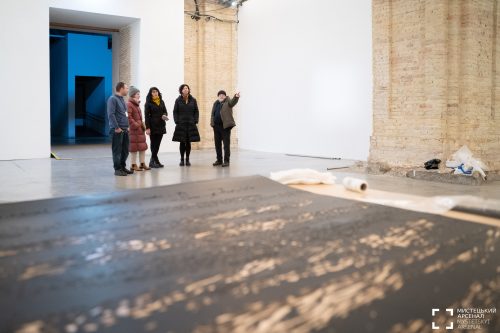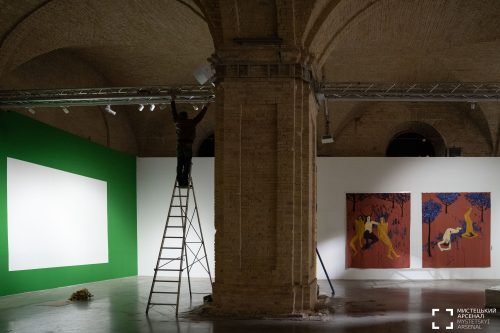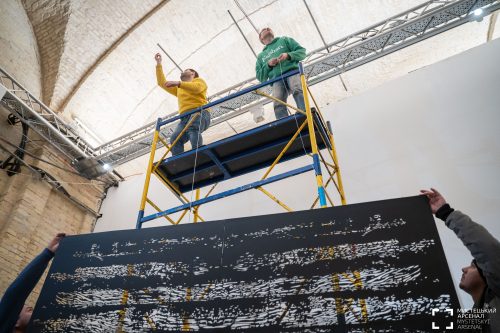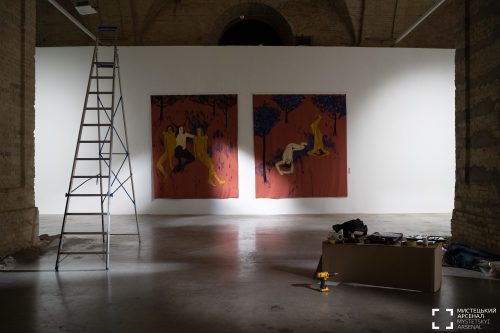Heart of Earth/ How Butterfly’s Wings are Flapping
In Greek mythology, there is a story about the founding of Athens: the gods Athena and Poseidon compete for power over the polis, offering their gifts to the citizens. By striking a rock with his trident, Poseidon gives a spring of water, which turns out to be salty. And Athena brings the olive tree, which gives fruit for food and shade for resting and thinking. The citizens of the polis choose Athena’s gift, and the city acquires a well-known name. American historian Timothy Snyder repeatedly mentions this plot in his numerous texts and lectures. He wittily asks: if the lands near the polis were planted with oil groves, then where was the bread that ancient Athenians ate with the fruit coming from? And he answers: the grain came from the Northern Black Sea region. It came from the lands that we know to be Ukrainian black earth—near Kherson and Mykolaiv, places where, throughout the written history of mankind, the crops grow that feed many nations.
This plot of the Ukrainian lands as the granary of entire continents seemed to be outdated, even empty and long since invalid, until the Russian invasion on February 24, 2022, highlighted its unexpected relevance. It turned out that this is not just a story, but an actual reality, an element of food security in the world, where the circulation of food is now, as well as—surprisingly!—thousands of years ago, depends on mass production in multiple locations and concentrated supply chains. And where control over the cultivation and transportation of food is still today the basis of the wealth of a limited circle of people and countries. This revealed something that the survival of millions of people depends on, but which over and over again falls into a blind spot, a gap in knowledge and understanding: food comes from the earth, just like gas and oil, and can also be used as a weapon. This is what the Russian blockade of Ukrainian ports demonstrates right now. Food shortages lead to political starvation and are therefore a tool for controlling people. This is a story that is tragically known in Ukraine—the Holodomor—and it is this story that colors the background against which Russia’s blockade of food circulation is currently unfolding.
While planning the exhibition, we draw an imaginary triangle: the earth, a human who cherishes it, and the food that is born from the interaction between them. The lack of this third element, food, kills humans, no matter where they are—in their field in Ukraine or on another continent in arid places devastated by long-term exploitation and climate change. Therefore, at first, we tried to clarify what is meant when they say earth.
The earth is terrain, certain land, and soil, from which plants grow and which cavities are full of water, a measure of prosperity and possessions, as well as a word to refer to a homeland, something native, a burial place, a significant cultural phenomenon, such as the novel Earth by Olha Kobylianska or the film Earth by Oleksandr Dovzhenko—in a sense, the main Ukrainian film, which itself leads a thoughtful viewer to a number of acute topics: distortion of reality by propaganda, the connection between culture and power, death of culture as a result of terror in the most direct meaning—through the death of people who produce it. Again, we feel the parallel with the current situation, to which the Russian war leads every day.
 |
 |
Photo: Oleksandr Popenko © Public Enteptise “NACMC ‘Mystetskyi Arsenal’”
Therefore, the earth we are talking about, what kind of land is that and what do we know about it in this triangle of food—human—earth?
These are remote places that we first read about in the texts by ancient Greek and Jewish authors. You may ask, remote from whom? They are remote from these authors, and therefore by the power of human imagination, they are inhabited by mythical creatures and filled with wonders. According to ancient sources, Amazons—female warriors—and cannibals, or Androphagi, lived here. Here, on Snake Island, rests Achilles, and here is Gilea (it is this legend that formed the basis of the game of the Ukrainian futurists who gathered in the suburbs of Kherson in the early 20th century), where the first Scythians were born from the demigod Herakles and the snake-legged goddess Api. For ancient authors, these lands are incomprehensible because they are spoken about by people who do not know them, and therefore, now and again, the story turns into an unstoppable colorful whirlwind of wonders. And this story, this way of describing the black earth of the Prychornomoria region had been used extremely long, for thousands of years, because at first, they belonged to the far north of the ancient world, and later to the Wild East of Europe, its boundless, uncultivated steppes. It is interesting that they are uncultivated, therefore, undeveloped by agriculture and food production. And, of course, numerous nomadic peoples live here all this time.
However, despite the really phantasmagoric nature of the description available to us, there is something that always puts these terrains at the center of practical human action: their fertility. And so, the grown food. And since the grains of the ancient world, and later of the early modern European empires, come from here, they turn out to be a source of political influence: just as fossil fuels will later become this source. Another historian, Yaroslav Hrytsak, writes about this, justifying how exactly the high productivity of Ukrainian (or at that time still late Ruthenian) black earth becomes part of global colonization: grains turn into a hard currency, which becomes especially valuable against the background of the devaluation of silver, which comes from Spanish overseas possessions—another mythical land discovered to Europeans by Christopher Columbus.
We seem to be dealing with two poles of the colonial transformation of the world, where each of them is an influential and rich source of energy, either in the form of grain or precious metal, but does not have its own voice. These are exploited territories, extremely influential but absolutely powerless. This is an interesting modus that could be described as influence without agency, that is, the ability to act on one’s own behalf and in one’s own interests. And that is why even to this day, to the times of seemingly all-encompassing rational knowledge, the southeastern lands of Ukraine are seen as a center of incomprehensibly wild creatures and events (Wasn’t it such a status of a chthonic malicious vortex that the Western political discourse had about the immanent corruption of everyone and everything in Ukraine? Wasn’t it felt in the annoying words of Donald Trump: “Ukraine is one of the most corrupt countries in the world”?).
 |
 |
Photo: Oleksandr Popenko © Public Enteptise “NACMC ‘Mystetskyi Arsenal’”
With the beginning of the full-scale war, these terrains, unknown to many, have acquired a detailed expression due to the resistance of their people. The names of local cities, towns, and villages are mentioned on the main world media sites, local correspondents are of great value, and millions of Ukrainians who were forced to flee their homes tell their stories to the world. Through resistance, the influence of mythologized lands and people began to converge with agency. However, we are once again dealing with threats to the earth, lands, life, and the need to talk about food that may become scarce. Researcher Asia Bazdyrieva, relying on the observations of Ilya Gerasimov, writes about the beginning of this protest movement on the Maidan—the Revolution of Dignity, which put dignity in the spotlight, that is, the need and ability to decide for oneself and speak on one’s own behalf.
The most tragic episode of those colonial efforts, which is at the center of Ukrainian memory, is Stalin’s policy of internal colonization. Yaroslav Hrytsak describes Stalin’s motives for organizing the Holodomor as follows: the USSR needed colonies to supply cheap resources for his vision of communist transformation. And not only Ukrainian lands remote from the center—Moscow—became such colonies, but also the Ukrainian peasantry. Stalin described his approach exactly in terms of colonization and saw it that way—according to similar practices of Western European ‘bourgeois’ empires, which grew due to the exploitation of Africa, India, the Caribbean, and many other overseas territories. The consequence of Stalin’s internal colonization was not only political famine of terrifying scale in Ukraine, but also further practices of ecological violence: for the extraction of resources, the earth was plowed up, water was polluted, and the air was poisoned. The Chornobyl disaster became the culmination point, which also unfolded on Ukrainian lands. Surprisingly we are still talking about the fertile black earth, which remains a center of pulsating life, despite everything.
Serhii Plokhy describes the connection between Ukrainian environmental movements and demands for democratization in the last years of the USSR. Based on colonial thinking, Soviet industrialization destroyed the ecosystem and increased the sense of threat, abandonment and betrayal among the people who lived there. Rumors about acid rains in Chernivtsi, kilometers of trees burned with toxins near Stebnyk, radiation as a deadly danger spilled into the air—all these make up the discursive reality of late Soviet Ukraine. Even the grown food seemed to be poisonous. That is why the beginning of the Ukrainian democratic movement was based mainly on the feeling of disastrous environmental violence: against the earth and people. One could overcome violence in the political plane, however, just like during the Holodomor, it again felt on the very physical level, it pierced a person in the most intimate way, one could not escape from it in any kind of internal emigration, it was right there, in your body. And also in the body of your earth and in the plants sprouted from it.
We are once again dealing with threats to the earth, lands, people, and the need to talk about food that may become scarce and therefore becomes suddenly visible. It is about something that was not noticed in the Ukrainian information space before the Russian invasion, and it is global, political, and deeply personal at the same time. Blocked ports, burned grain, devastated and poisoned earth in Ukraine, like the flap of a butterfly’s wings, has consequences much farther in other places, which, too, were systematically oppressed and are now suffering from the consequences of industrialization, which was not chosen by the local people. Food, the fragility of the human body, and the condition of the earth are once again tied in a tight knot.
 |
 |
Photo: Oleksandr Popenko © Public Enteptise “NACMC ‘Mystetskyi Arsenal’”
The connection between everything became palpable: between very different lands, between people who knew little about each other’s suffering, between plants and people, between earth and food, and the individual. As before, what can help is resistance, both political and military. Courage and the ability to resist. However, not only this. Thinking about ourselves and the communities of people who have historically lived on the same lands, raising our voices and telling our own stories with fewer wonders but more connections between events and their participants, mourning our pain and laughing at the thousand jokes that are born every moment are all ways to cope with violence. And another important way is the ability to care.
Anna Pohribna, co-curator of this exhibition, shared an observation of her own family history: even those who never worked on the land, having inherited it, treated the land not as property, but as something for which they suddenly had a responsibility. They had to cultivate their land sparingly. And it wasn’t so much growing food as it was a strategy of caring, and there can be many ways to care.
For example, care about mined fields that need careful demining, about people who deserve to work the land safely and not to know the stories of those blown up by a trip-wire, about everyone who needs food and who carries the memory of hunger in themselves, the memory that sounds from the bottom of one’s imagination, about the earth that is no longer poisoned either by bombs or unthinking production, about exiles and their gardens somewhere in the southern Ukrainian lands, gardens whose neglect echoes with sharp pain every moment. Care about us all.